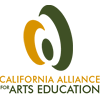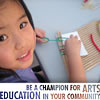U.S. Dept of Ed Supports Arts Education in Title 1 Program
At the 2014 National Title I Conference, Dr. Monique Chism, Director of Student Achievement and School Accountability Programs at the Department of Education, took a stand for arts education within the Title I program. Not only did she share her conviction that “arts education ensures that underserved students in public schools, particularly low income students and English-learners do better in school and [...] have the greatest relative improvements in academic achievement when participating in arts programs,” but she also shared a personal story of how the arts impacted her as a young person. (See video below).
This clear support from the highest levels of Title I leadership has helped to shift understanding among local, state and national school leaders about the appropriate role for arts education strategies within the Title I program.
"It's not Title I funds supporting arts education – arts education can support Title I goals,” says Joe Landon, Executive Director of the California Alliance for Arts Education who spearheaded a campaign to clarify policy around this issue. “A substantial body of research demonstrates that certain forms of arts education can be an asset to schools and districts in improving math and reading skills, increasing parent involvement and other goals of the Title 1 program.”
Despite this, a 2011 survey conducted by Arts for All, found that students attending Title I schools in Los Angeles had disproportionately low access to arts education compared to more economically advantaged peers. This finding echoed results of a national survey on arts education conducted by the U.S. Department of Education.
Prompted by this survey and an invitation from Arts for LA, Los Angeles County’s leading arts advocacy organization, the California Alliance set out to explore the role that arts education could play in Title I. The intention was to support schools and districts in embracing the arts among their strategies for achieving Title I goals and realizing the benefits of arts education for students evidenced in arts education research.
Federal Title I policy allows schools and districts to include arts education in their strategies to achieve Title I goals but downstream of the federal level, the Alliance found, was a lack of clarity about whether and how the arts could play a role in Title I. Coupled with the culture of “fear of reprisal” that seemed to permeate the Title I world - where funding could be retracted if a program didn’t meet state or federal expectations- this lack of clarity was preventing schools and districts from including arts education in their Title I strategies, or at least deterring them from doing so publicly.

In response, the Alliance worked to clarify a policy pathway—a shared understanding aligned across school, district, state, and federal levels of leadership regarding what is allowable when it comes to expending Title I funds on arts education. Those efforts and are documented a Policy Paper by the Alliance, which offers a roadmap for districts, who wish to pursue arts education strategies to meet Title 1 goals.
Now, the Alliance is working with a cohort of California schools to create a model that can be shared with other schools and districts. The results will be shared in a second policy paper and in a series of eight regional convenings to help others throughout the state understand the appropriate use of Title I funds to support arts education strategies.
In collaboration with the California County Superintendents Education Services Association (CCSESA) and the Alliance’s long-term consulting partner on Title I arts integration, Lauren Stevenson of Junction Box Consulting, the Alliance will launch an online resource to help guide school leaders through using the Title I annual school plan planning cycle to plan and evaluate Title I arts education strategies as well as tools and resources that they might need to successfully execute each of the cycle’s seven steps. The Alliance will bring the cycle to life by providing, for each of the seven steps, at least one case example of how a school has used key related tools and resources.










